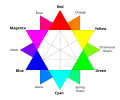| Lilac | |
|---|---|
 | |
| | |
| Hex triplet | #C8A2C8 |
| sRGB B (r, g, b) | (200, 162, 200) |
| HSV (h, s, v) | (300°, 19%, 78%) |
| CIELChuv (L, C, h) | (71, 32, 308°) |
| Source | [1] |
| ISCC–NBS descriptor | Light purple |
| B: Normalized to [0–255] (byte) | |
Lilac is a light shade of purple representing the average color of most lilac flowers. The colors of some lilac flowers may be equivalent to the colors shown below as pale lilac, rich lilac, or deep lilac. However, there are other lilac flowers that are colored red-violet.
Contents
- Variations
- Pale lilac
- Bright lilac
- Rich lilac
- French lilac
- In nature
- In culture
- See also
- References
- External links
The first recorded use of the term lilac as an English color name was in 1775. [2]


